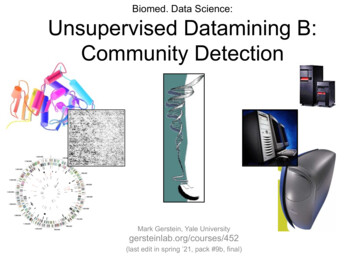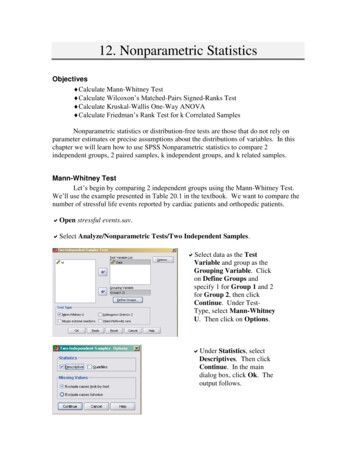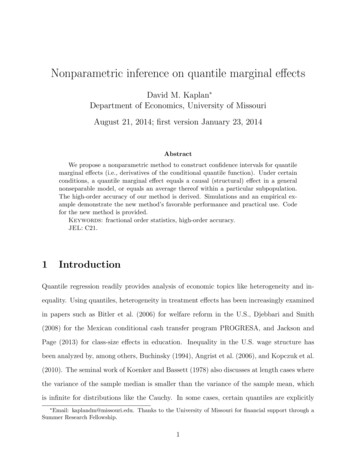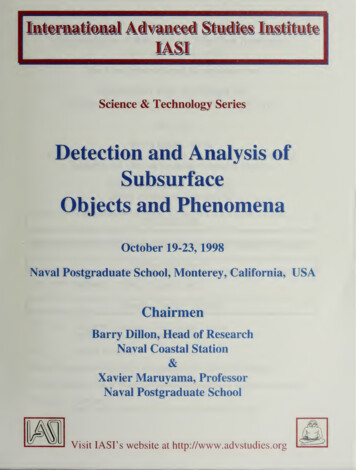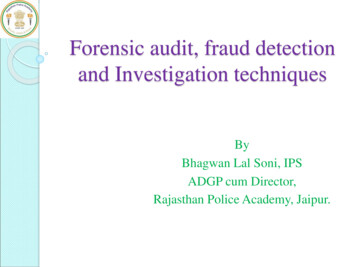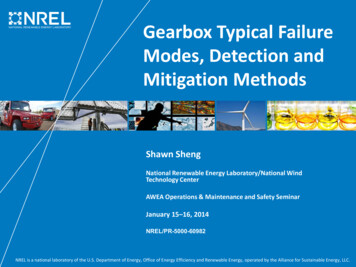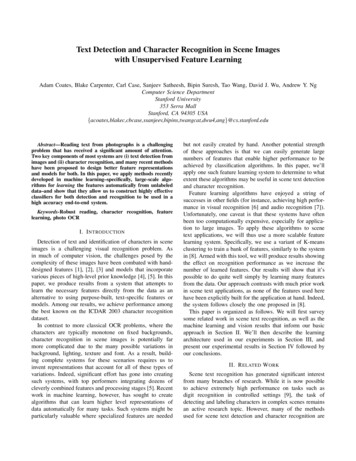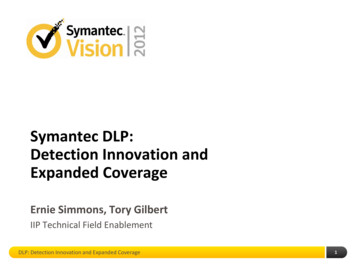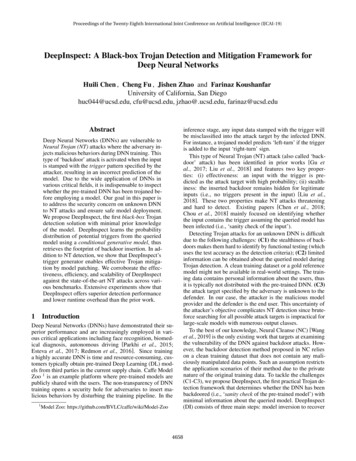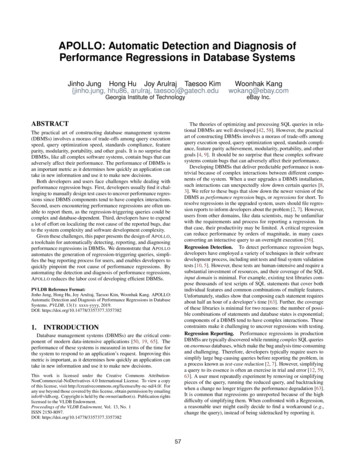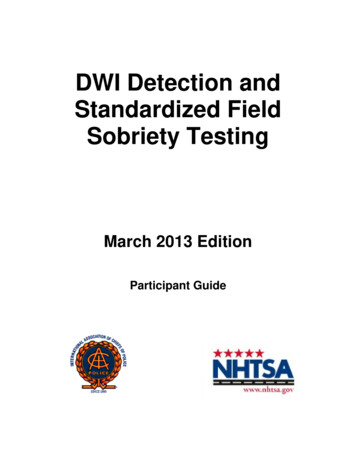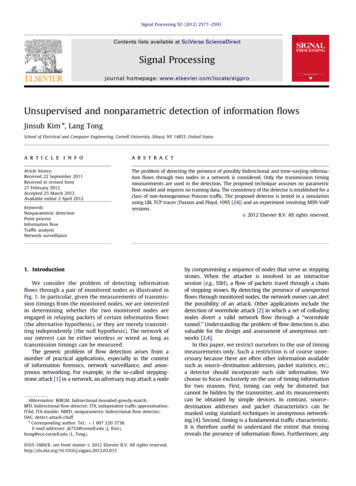
Transcription
Signal Processing 92 (2012) 2577–2593Contents lists available at SciVerse ScienceDirectSignal Processingjournal homepage: www.elsevier.com/locate/sigproUnsupervised and nonparametric detection of information flowsJinsub Kim n, Lang TongSchool of Electrical and Computer Engineering, Cornell University, Ithaca, NY 14853, United Statesa r t i c l e i n f oabstractArticle history:Received 22 September 2011Received in revised form27 February 2012Accepted 25 March 2012Available online 2 April 2012The problem of detecting the presence of possibly bidirectional and time-varying information flows through two nodes in a network is considered. Only the transmission timingmeasurements are used in the detection. The proposed technique assumes no parametricflow model and requires no training data. The consistency of the detector is established for aclass of non-homogeneous Poisson traffic. The proposed detector is tested in a simulationusing LBL TCP traces (Paxson and Floyd, 1995 [24]) and an experiment involving MSN VoIPsessions.& 2012 Elsevier B.V. All rights reserved.Keywords:Nonparametric detectionPoint processInformation flowTraffic analysisNetwork surveillance1. IntroductionWe consider the problem of detecting informationflows through a pair of monitored nodes as illustrated inFig. 1. In particular, given the measurements of transmission timings from the monitored nodes, we are interestedin determining whether the two monitored nodes areengaged in relaying packets of certain information flows(the alternative hypothesis), or they are merely transmitting independently (the null hypothesis). The network ofour interest can be either wireless or wired as long astransmission timings can be measured.The generic problem of flow detection arises from anumber of practical applications, especially in the contextof information forensics, network surveillance, and anonymous networking. For example, in the so-called steppingstone attack [1] in a network, an adversary may attack a nodeAbbreviation: BiBGM, bidirectional-bounded-greedy-match;BFD, bidirectional flow detector; ITA, independent traffic approximation;ITAd, ITA-double; NBFD, nonparametric bidirectional flow detector;DAC, detect-attack-chaffnCorresponding author. Tel.: þ1 607 220 3738.E-mail addresses: jk752@cornell.edu (J. Kim),ltong@ece.cornell.edu (L. Tong).0165-1684/ - see front matter & 2012 Elsevier B.V. All rights 3.015by compromising a sequence of nodes that serve as steppingstones. When the attacker is involved in an interactivesession (e.g., SSH), a flow of packets travel through a chainof stepping stones. By detecting the presence of unexpectedflows through monitored nodes, the network owner can alertthe possibility of an attack. Other applications include thedetection of wormhole attack [2] in which a set of colludingnodes divert a valid network flow through a ‘‘wormholetunnel.’’ Understanding the problem of flow detection is alsovaluable for the design and assessment of anonymous networks [3,4].In this paper, we restrict ourselves to the use of timingmeasurements only. Such a restriction is of course unnecessary because there are often other information availablesuch as source–destination addresses, packet statistics, etc.;a detector should incorporate such side information. Wechoose to focus exclusively on the use of timing informationfor two reasons. First, timing can only be distorted butcannot be hidden by the transmitter, and its measurementscan be obtained by simple devices. In contrast, source–destination addresses and packet characteristics can bemasked using standard techniques in anonymous networking [4]. Second, timing is a fundamental traffic characteristic.It is therefore useful to understand the extent that timingreveals the presence of information flows. Furthermore, any
2578J. Kim, L. Tong / Signal Processing 92 (2012) 2577–2593Fig. 1. In the above wireless network, the transmission timings of two nodes, N1 and N2 , are recorded. The horizontal axis is the time axis, and arrowsrepresent packet transmissions at different time points. As illustrated, packets of certain information flows may travel through N1 and N2 .side information, when incorporated properly, will enhancethe performance of techniques based solely on timinginformation.Even though transmission timings of nodes can beeasily monitored, detecting information flows based ontiming is non-trivial, partly because of non-stationarytraffic characteristics: transmission timings of nodes oftenhave time-varying intensities, and they may be burstywhen interactive users are involved. Moreover, in general,it is difficult to obtain an accurate parametric model for themonitored traffic, especially when there is no prior knowledge about the nature of the traffic and no training dataavailable. The presence of noise-like epochs is anothersource of difficulty. When an information flow travelsthrough two nodes, the two nodes may have transmissionsthat do not belong to the flow. They may multiplextransmissions of other flows that go through only one ofthe two nodes, or intentionally superpose dummy transmissions to avoid detection. We refer to the epochs of suchtransmissions as chaff epochs.It is easy to see that, if a node can arbitrarily delaypackets in a flow, timing information is insufficient fordetection. For latency-sensitive applications such as VoIP,multimedia streaming, etc., however, packets must satisfycertain end-to-end delay constraints, which make the presence of such flows detectable. For instance, VoIP applications require end-to-end delays to be bounded above by150 ms [5]. This paper will consider the constraint that flowpackets should satisfy the end-to-end delay constraint ofD seconds.1.1. Related worksDetection of information flows has been studied in thecontext of intrusion detection, especially in the detection ofinteractive stepping-stone attacks [1]. The use of timingonly measurement for detection is motivated by the factthat packets involved in an attack can be easily encrypted.Donoho et al. [1] were among the first to consider the flowmodel with a uniform delay bound. Following their model,many algorithms have been proposed to detect a flow witha delay constraint. As an active detection scheme, Wanget al. [6] proposed a watermark-based detector whichembeds watermarks by slightly adjusting transmission timings of a node; if the same watermarks are detected inanother node, two nodes are claimed to have flows betweenthem. Their work was followed by a large number ofwatermark-based detectors [7–14]. The insertion of watermarks, however, requires the ability of the detector tomodify traffic at different locations of the network, whichmay not be possible in practical situations.If the network traffic cannot be modified to facilitatedetection, the problem is referred to as passive flow detection. Zhang et al. [15,16] proposed matching-based algorithms. However, they assumed that only one of two nodescan insert chaff transmissions, and their algorithms arevulnerable to chaff insertion at both nodes. Donoho et al.[1] proposed a wavelet analysis with a claim that it candetect a flow in chaff if the chaff part is independent of theflow part and the sample size is sufficiently large. Blum et al.[17] presented a counting-based method which was shownto be able to detect a flow in chaff if the fraction of chaff issmall enough. Under the Poisson traffic assumption, theycharacterized the sufficient sample size for satisfying a givenfalse alarm probability constraint. However, their methodmay result in high miss detection probability if chafftransmissions are bursty. He and Tong [18] proposed amatching-based detector with better chaff tolerance andcharacterized the maximum tolerable fraction of chaff underthe homogeneous Poisson traffic assumption. Their approachrequires choosing a detection threshold which is a functionof the parameter of the underlying Poisson traffic. When thetraffic deviates from the Poisson model, the detection algorithm is not always robust. The approach in [18] can beapplied to the general traffic if a training data with asufficiently long time span is available. Coskun and Memon[19,20] presented detectors based on random projection oftransmission processes. Similar to [18], their methods alsorequire choosing an appropriate detection threshold, whichcan be successful only if a large volume of training data or anaccurate parametric model is available.Statistical inference on timing measurements has beenstudied in various other fields. In communication viatiming channels [21,22], a transmitter embeds a messageinto its packet transmission timings, and a receiver infersthe message based on its packet arrival timings. Inneuroscience, spike train observations of neurons formsequences of timings, and they are analyzed to infercausal relations among neurons [23].1.2. Summary of results and organizationThe main results of this paper include three parts: anonparametric flow detection algorithm for unidirectionalor bidirectional flows, the related performance analysis,and experiments with synthetic and real data. In developing an algorithm, our main contribution is a newnonparametric technique that does not rely on knowledgeof traffic distribution; nor does it require a training datafor either hypothesis. The key idea lies in a particulartransformation of the measurements that leads to distinctstatistical behaviors under two different hypotheses. The
J. Kim, L. Tong / Signal Processing 92 (2012) 2577–25932579Fig. 2. Every packet transmission of a unidirectional flow is assumed to satisfy packet conservation, causality, and the delay constraint D.proposed detector does not assume stationarity of trafficand hence is applicable in time-varying traffic conditions.Furthermore, it is memory-efficient and has linear computational complexity with respect to the sample sizethereby making real-time inference feasible.In algorithm analysis, we aim to give theoretical justifications for the proposed approach. To this end, we establishthe consistency property of the proposed detector for a classof non-homogeneous Poisson traffic. Even though thedetector is analyzed only for non-homogeneous Poissontraffic, the intuition behind it suggests that it may performwell on the traffic with more general distribution.The performance of our detector is evaluated usingsynthetic Poisson traffic, LBL TCP traces [24], and real-worldmeasurements from MSN VoIP sessions, and comparisonwith other passive detectors is provided. The use of synthetic data allows us to examine the trade-offs betweenmiss detection and false alarm probabilities using MonteCarlo simulations. LBL TCP traces and MSN VoIP traces are ofcourse not guaranteed to satisfy the assumptions made inour algorithm analysis, and our results indicate a level ofrobustness.The rest of the paper is organized as follows. Section 2gives the notations and definitions employed throughoutthe paper and formulates flow detection as a binarycomposite hypothesis testing problem. In Section 3, weconsider the simpler case where the parametric model ofthe traffic is available. Then, Section 4 presents a nonparametric flow detection algorithm and its consistencyproperty. Theorems are stated with proofs presented inthe Appendix. In Section 5, the proposed detector isevaluated using synthetic Poisson traffic, LBL TCP traces,and MSN VoIP traffic. Finally, Section 6 concludes thepaper with remarks.element of the sequence of all the elements of ðai Þ1i ¼ 1 andðbi Þ1i ¼ 1 ordered in the increasing order.First, we define a unidirectional flow as follows.Definition 2.1. An ordered pair of point processes ðF1 ,F2 Þforms a unidirectional flow, if for any realization ðf 1 ,f 2 Þthere exists a bijection g : F 1 -F 2 satisfying gðsÞ s 2½0, D for all s 2 F 1 .As illustrated in Fig. 2, when packets of an informationflow travel through node N1 and node N2 , F1 and F2 can beinterpreted as the transmission timings of the flow packets at N1 and N2 respectively. The bijection condition of gmeans packet conservation; every flow packet sent by N1is received and forwarded by N2 . The condition gðsÞ s 2½0, D means that every flow packet transmission satisfiescausality and the delay constraint D. Based on the abovedefinition, we define a bidirectional flow as a superpositionof two unidirectional flows with opposite directions.Definition 2.2. A pair of point processes ðF1 ,F2 Þ forms a21bidirectional flow, if Fi can be decomposed into F12i and Fi122112 1221 21(i.e., Fi ¼ Fi Fi ) such that ðF1 ,F2 Þ and ðF2 ,F1 Þ areunidirectional flows.1221 21We allow ðF121 ,F2 Þ and ðF2 ,F1 Þ to have zero rate, so thata unidirectional flow is a special case of a bidirectional flow.2.2. Problem statementWe formulate detection of bidirectional flow as a binarycomposite hypothesis testing problem. Let S1 and S2 denotethe transmission processes of N1 and N2 , respectively. Giventhe measurements ðsi Þ2i ¼ 1 in ½0,t , we test the followinghypotheses:H0 : S1 and S2 are independent;2. Mathematical formulationH1 : Si ¼ Fi Wi , i ¼ 1; 2,This section introduces notations and definitions andformulates flow detection as one of binary compositehypothesis testing.2.1. Notations and flow modelsTransmission timings of each node are modeled as apoint process on ½0,1Þ, and detectors begin recording thetimings at time 0. Bold upper-case letters (e.g., S) denotepoint processes, and bold lower-case letters (e.g., s) denotetheir realizations. S(i) represents the ith epoch (i.e., the timeof the ith transmission) of S, and s(i) is its realization. Theupper-case script letter S denotes the set of epochs in therealization s : S9fsðiÞ, i Z 1g. In addition, we define a superposition operator : given two increasing sequences ðai Þ1i¼1111and ðbi Þ1i ¼ 1 , ðai Þi ¼ 1 ðbi Þi ¼ 1 ¼ ðci Þi ¼ 1 , where ci is the ithandðF1 ,F2 Þ forms a bidirectional flow:We further assume that, under H1 ,1. F1 and F2 are point processes with non-zero rates.12. F1 and F2 are not independent.3. ðF1 ,F2 Þ, W1
multimedia streaming, etc., however, packets must satisfy certain end-to-end delay constraints, which make the pre-sence of such flows detectable. For instance, VoIP applica-tions require end-to-end delays to be bounded above by 150 ms [5]. This paper will consider the constraint that flow packets should satisfy the end-to-end delay constraint of
